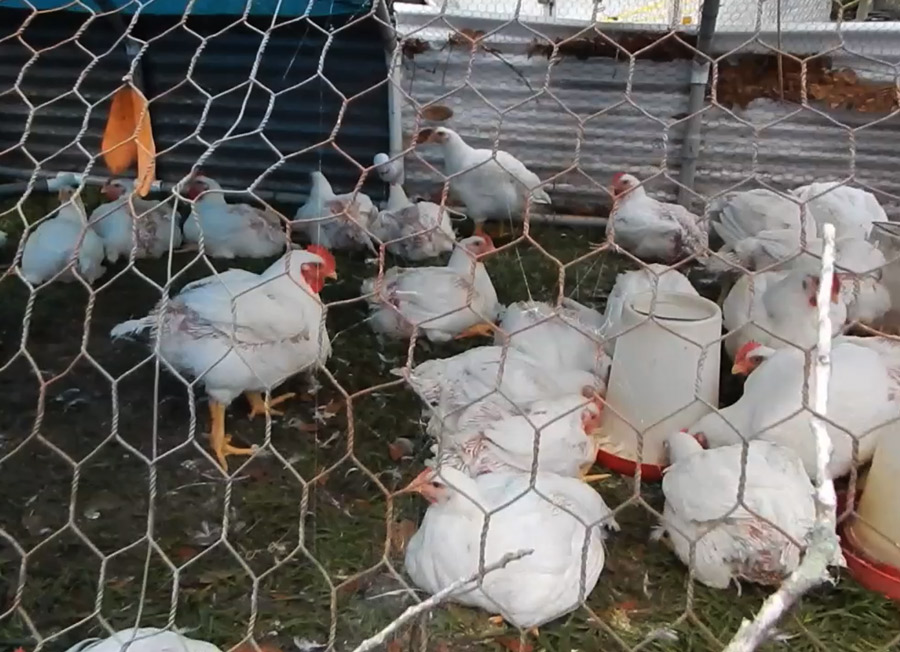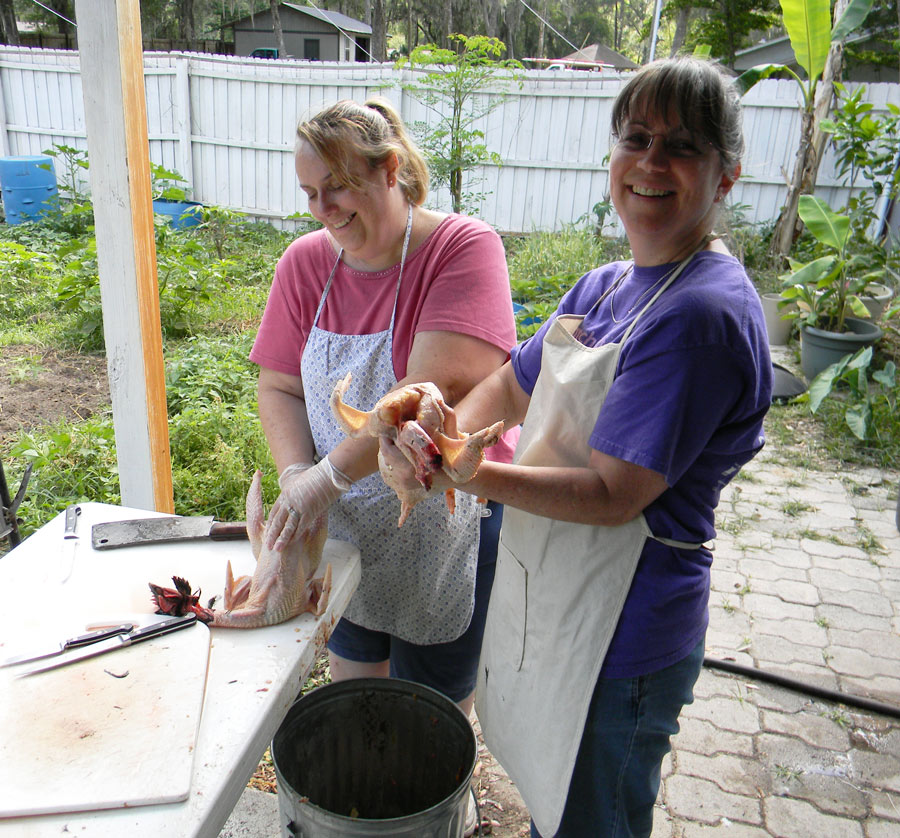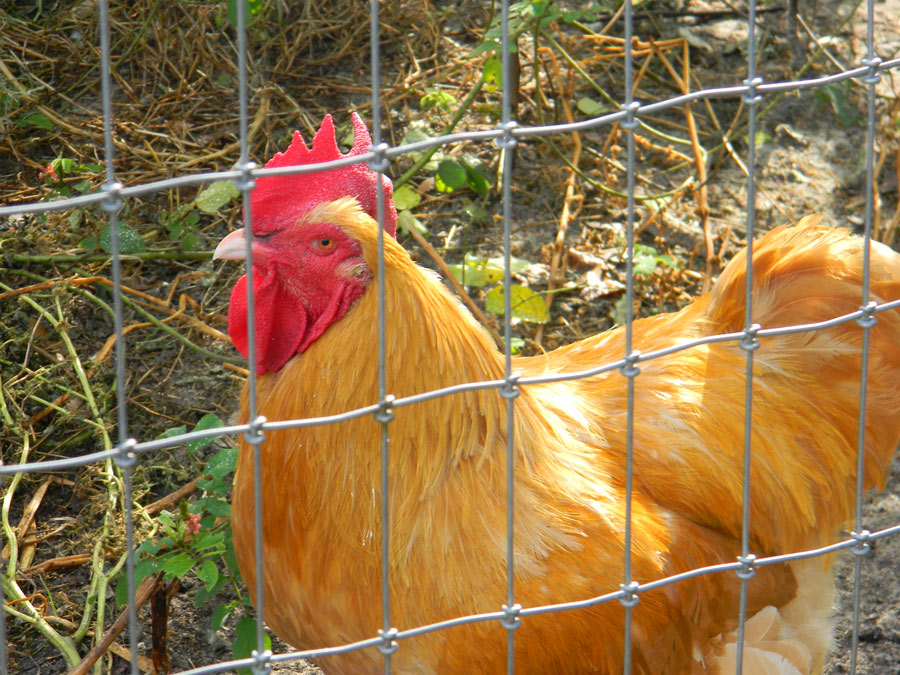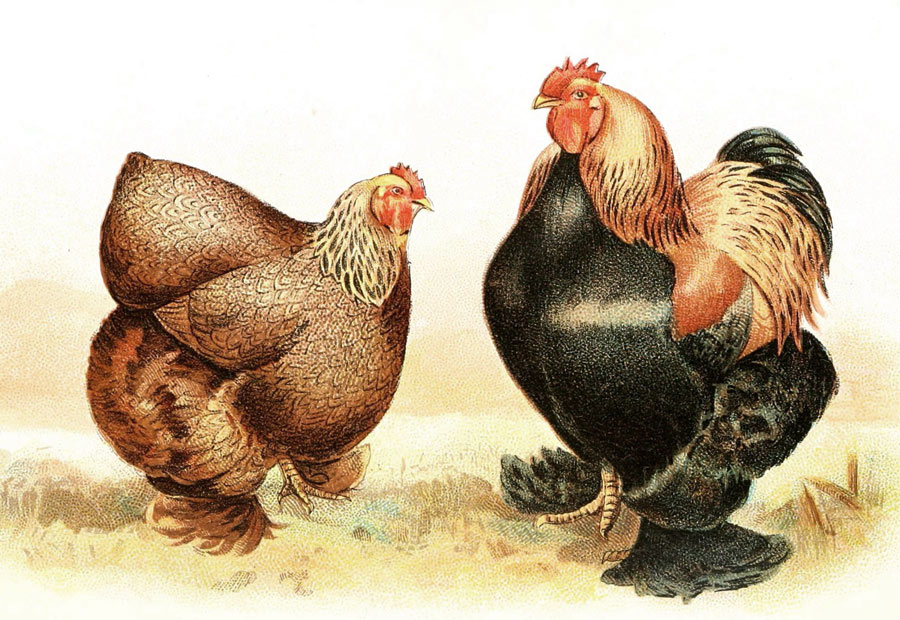What breed of chicken is best?
Today I’m continuing my Chickens 101 series with my observations on the various breeds of chickens we raised in our Florida yard.

To answer the question, we first need to consider the meat vs. eggs question. We’ll start with meat, then get to the laying breeds next, since most backyard chicken keepers are more interested in fresh eggs than in slaughtering their own chicken pot pies.
Meat Birds
There are breeds of chicken that are bred solely for their meat. The most common example is the Cornish Cross. That’s the variety raised by commercial chicken farmers, Joel Salatin and most backyard farmers.

Cornish Cross chickens look and act like the result of a GMO experiment gone wrong. They’re ugly, stupid, and are fat and lazy. They just don’t have the intellectual spark of other breeds. When you look at them, you’re looking at a quick meal.
We’re talking very quick, too. Cornish Cross birds are ready to be “harvested” in eight weeks! That’s impressive. Their meat is tender and delicious, even if raising and slaughtering them isn’t fun.
One trick I discovered for making slaughtering tolerable is to have friends over. Particularly friends who are NURSES!

Nurse Cristina and Nurse Cathy don’t care if meat birds are yucky
Nurses can handle all kinds of yucky stuff. Make friends with them. Trust me on this.
We raised two rounds of meat birds some years ago and just gave up on the process. The birds stink, they eat like pigs, they’ll have random heart attacks and die if you don’t harvest them on time, and my wife just thinks they’re icky. Which they are.
There are breeds of meat bird that are less disgusting than the Cornish Cross, though they don’t get big as quickly. A recently created breed is the Freedom Ranger(TM), but I haven’t raised those personally so I can’t attest to their behavior or flavor.
In general, I’d rather simply raise dual-purpose chicken breeds and then eat most of the roosters and the hens that get too old to lay well.
Let’s take a look at some of these varieties.
Dual-Purpose Chicken Breeds
Most of the chicks you’ll see for sale in the local feed store (provided you live in the country, as every good person should) are dual-purpose chicken breeds.
This means they have large enough bodies to be suitable for eating, but they’re also decent egg-layers. Barred Rocks, Rhode Island Reds, Buff Orpingtons and Silver-Laced Wyandottes fit into this catagory.
I find that the hens of these breeds, though tasty, are not calorically impressive compared to their freakishly large-breasted Cornish Cross cousins. Buff Orpingtons are probably the biggest dual-purpose bird of the chickens we’ve raised, but they’re so pretty and friendly I find them hard to kill.
Rhode Island Reds are scrappy birds that are stand-offish for the most part – they just aren’t all that sociable in my experience. If you want a pet chicken, go with a Buff Orpington.

One of our beautiful Buff Orpingtons
Where the Rhode Island Reds shine is in their ability to forage and lay consistently. Tough birds.
We’ve also raised the Black Star sex-link birds and found them to be quite similar to the Rhode Island Reds. The Barred Rocks and Silver-Laced Wyandottes are both good birds but aren’t all that big for the table… and they’re not quite as good at laying as Rhode Island Reds or Black Stars.
Though Buff Orpingtons are quite pretty and friendly, they don’t lay as well as any of the other dual-purpose breeds I’ve mentioned so far. They lay decently, but they’re not quite up to the production levels I like to see when I’m paying for feed.
All of these varieties lay brown eggs of good size.
What if You Just Want Eggs?
My favorite egg-laying chicken breed is the regular old Leghorn. They’re funny, scrappy, white, small-bodied birds that lay great big white eggs.They also have cute floppy combs on the tops of their heads and have been quite sweet-natured.
Their laying is like clockwork.
I really love these birds, but they’re too skinny to be much of a meal if you decide to eat non-productive birds, hence the reason I would classify them as an egg-only bird.
Skip the Goofy Chicken Breeds
When you look through an online catalog of chicken breeds, the sheer variety becomes a temptation.
“Hey – we could get birds that lay blue eggs!”
“Wait, what about those ones with the mop-tops?”
“Whoa, look – this heirloom breed lays chocolate-brown eggs!”
I used to have an aunt who kept Blue Cochins. They were friendly, dopey birds with big bodies but like many of the showy chicken breeds, Cochins aren’t all that great at laying.

I suppose if you wanted lawn ornaments, you could pick a funny breed – but if you want to turn chicken feed into chicken eggs, skip the silly types.
We’ve also raised “Easter-Egger” chickens, AKA Ameraucanas, and found them to be foul-tempered and flighty birds in general, plus they don’t lay all that well. The eggs are cool but the return on investment is blah.
My Chicken Breed Recommendations
So – what breed of chicken is best? If you want meat, the icky Cornish Cross. If you want eggs and some meat, Rhode Island Reds or Black Stars. If you just want eggs, get the White Leghorn.
If I were restarting my own backyard chicken operation right now, I’d get a mix of Leghorns, Rhode Island Reds and Black Stars. I want some meat and some eggs, so my flock would produce both. I’d let them interbreed over time, perhaps adding in some Buff Orpingtons for the larger bodies, then incubate the eggs.
Every generation I’d select for the largest and best layers, as well as the best foragers and the brightest birds until I’d created a run of birds I was happy with. We mixed a selection of good breeds together in the past to try and make our own unique flock; however, that breeding experiment came to an unfortunate racoon-induced end in its second generation.
Now if we could just cross a pit bull with a Rhode Island Red, we’d be all set…


27 comments
I have a couple of Black Stars for eggs only. After helping my parents kill chickens for meat when I was a kid, I refuse. Too gross for me. I love the black stars, got them as baby chicks and have had them for over a year. They lay almost every day. They free range in our yard during the day and they get locked in the coop at night.
I have to add Black Australorps to your list though, they are amazing chickens, very close to the Black Stars in their attitudes and laying abilities.
The first time I butchered birds it was really rough. I’ve gotten mostly used to it over time, but I truly understand your feelings. If I wasn’t committed to home-raising as much of our meat as possible, I’d have never continued.
And thanks for the breed report – we never got to try Australorps.
We long ago had chickens that came and left in regards to predators.But when a gunny hen was added to the mix that bird was the look out for the flock and less predators go their dinners at the farm.
The other thing about those fast growing birds is that the meat must be less nutritious. How can you grow a nutritious body in 6 to 8 weeks? The bones are soft too. I always wonder how they can even get them old enough breed the things. To me, it’s hard to beat the eating quality of one year old free ranging birds. Black Australorps are a good dual breed. Not my favorite personality wise, but they are record egg layers and big birds. I’m partial to speckled sussex as a dual bird and they are also very neat looking.
cornish cross aren’t bred from like parents, it’s actually a reproductive dead end (think mule), they don’t get old enough to lay and the males would be sterile, plus their legs won’t hold up a body of an adult if you even let them live that long. It’s a cross between cornish and (usually white) rock chickens. I’m a fan of backyard mixed breeds, like mutt dogs you tend to get the best but not the worst of the parents. They may not lay quite as regularly as “egg” breeds but they’re hardier and better foragers, freeing up some on the feed bill.
Oh right, I think I knew that once :) A lot of mine are mutts now. It’s been years since I bought any chickens and most are mixed now. They seem to lay okay. I try to get a new rooster every year to prevent in-breeding. A lot of them don’t make it because of predators, so there is definitely some natural selection going on.
Yes – that’s one of the reasons I recommend letting a flock breed together and adapt. Good foragers = good homestead birds! Thank you, Rachel.
Good point on the fast growth. Personally, I’d much rather eat a tougher bird from a traditional breed (or a mutt) than a Cornish Cross – but even the Cornish Cross birds we raised tasted SO MUCH better than factory chickens that it was still worth it.
Like you said, this is an individual decision based on your needs and location. We used the Livestock Conservancy –
https://livestockconservancy.org/index.php/heritage/internal/conservation-priority-list#Chickens – to choose the Plymouth Rocks since they were dual purpose, docile and cold hardy. It is a plus that we are help to preserve a heritage breed.
Hmmm. My colored egg layers are gentle and personable. I wonder if it’s because some of them were experimental crosses (White Rock x Araucana, Rhode Island Red x Araucana, Buff Orpington x Araucana) with a dash of game chicken and various bantams thrown in.
I’ve got some Rhode Island Reds that have attitude problems, but I’ve also got Wyandottes with attitude problems. The Buff Orpingtons aren’t the greatest egg layers and are pretty dumb by chicken standards, but they are pretty. I use my chickens more as bug destroyers and fertilizer factories so, as long as I get a dozen eggs per day, I’m happy.
It might be the crossing or it could just be our aruacanas were all weirdos.
Rhode Island Reds are a bit standoffish. And you nailed it with Buff Orpingtons – dumb and pretty! :)
I’ll agree with looking up the Livestock Conservancy. Heritage breeds, are the best, to survive. Some may not grow out as fast as the industrialized commercial breeds. (Slow food movement)
Then again every Turkey in the supermarket, can not reproduce on it’s own. They are all artificially inseminated. How sick is that? I will never buy such products.
So back to real food here. Is my best advice. L.C. has a list of breeds. The list includes egg laying,(some breeds better than others. meat birds, & temperament too. ) Other good info there. Most members raise heritage chickens.
I raise a breed of rabbit on the L C list. I am not into raising birds.
All I can say is the owners of commercial breeds, can be very disgusting. Crack an egg open & it’s a bloody, mush mess in the pan. The hens have never even seen a rooster, to make the bloody egg fertile. I think it’s the GMOs in the feed, that causes this? Non GMO fed hens, that are heritage breeds, never disappoint me. When I buy eggs.
►I vote with my cash. I buy heritage breed, organically grown eggs. Never a bloody mess in the frying pan.◄
The plus side to my saying this; is that raising a rare endangered breed. Will prevent further livestock extinction. We are loosing our heritage gene pool. The very DNA that could save, the entire food supply. It also feels good to go out there to feed your heritage animals, & know you are doing something to prevent barnyard extinction. My breed of rabbit has been upgraded from critical (less then 500 in global population) to threatened. (500- 1000 in global existence. ) Go with organically raised heritage breeds. I’ll buy from your farm, if you do.
Thanks for the agreement on the LC. I am also raising rabbits from the list, American’s. Next up is a couple San Clemente goats!
I got into (L C list heritage rabbits) Americans & Silver Foxes. First was the Silver Foxes. Then I added the Americans. The Silver Foxes seem to be more hearty, & live much longer. It could be lineage. Or just that Flemish Giant blood, in the American breed?. Flemish Giants live about 3 years. I have only had 1 American white, last over 5 years. My last one. He is still with me @ 5 1/2 years. I doubt he will make it to age 6. I am keeping the Silver Fox line going. Very hearty. Do you keep pedigrees? Or show your Americans? I am into color genetics. Americans have a very rare color gene. Most of them anyway. It’s called Extension Dark (Ed gene). The most dominant gene in E locus. This is why they are the most dark blue in color. They also are the 1st breed ever created in the USA. Dog like personalities. Very sweet rabbits to have. I too really like the San Clemente Island Goats. Wow what survivors. What a story! What beautiful goats. Maybe someday. I will also have them too?
Nothing beats true life experience for information considering all the disinformation online. Am really enjoying these articles on chickens since I will be needing it in the near future on the farm. Considering we are what we eat I have a better understanding some of the problems plaguing our society after seeing the Cornish cross chickens in action. We have a couple of orpingtons as pets for the kids for about a year and a half now. They do have a nice temper and is nice having pets that lay eggs. The kids really enjoy them. They lay about an egg a day to every other day depending on how well they eat. Can’t complain. It is interesting noting that given the preference they are partial to eating a lot of different greens and bugs instead of grains. They go crazy over green pigeon pea and even like munching on fire bush leaves which I’ve read is medicinal in many ways. I guess nature really is a great teacher if you take the time to observe it. Any way, am looking forward to future articles so that I can be better informed when I begin my own trials on the farm. Thanks again for the information keep up the good work.
The chickens, & Peafowl, from next door, sometimes wander over to my place. They are crazy for Alfalfa Hay. Which is a good protein source. Give it a try. I buy it for my rabbits. Since I do not feed commercial feed. Adding a good source of phosphorus, (for rabbits) is a must. The hay alone is way too high in Calcium. With the calcium :phosphorus ratio.
Not sure about chickens? Perhaps the extra calcium is perfect?
I agree. I am so happy to be part of this educational blog.
I got the Rhode Island Reds as my first batch of chickens, so I’m biased toward them. Good egg layers and good size for becoming dinner one day. But they do complain a lot. Never happy even when I let them free range. lol. Then I got some white Leghorns and some black ones (don’t remember the name), and they have become my favorites. Good egg layers, docile, and happy. But their bodies are smaller than the Reds, so that’s the only downside.
I built a cylinder-shaped coop prototype that rolls on the ground when you need to move it. Planned to make a bigger model, but I never got time to do so. Neat concept.
I like Buff Orpingtons and Barred Rocks. I wanted to try White Rocks this time, but the hatchery couldn’t come up with any on a decent timeline. So I bought barred Rocks. The upside in my opinion is they lay well, are cold hardy, are well mannered, and I can hatch their eggs in my incubator without worrying about hybrid traits not carrying.
I am trying rabbits right now for meat. They are simpler to butcher than chickens, and delicious. But still, I’m not sure it’s worth the effort. If you have access to hay, they can be very cheap to raise.
We’ve had a lot of luck with our White Leghorns. A little skittish, but they are consistent layers, only slowing down during the dead of winter.
Our biggest problems with chickens is predators. We have about 15000 square miles of woods nearby, and it’s full of owls. We’ve also got river marshy less than a 1/4 mile away, with weasels, raccoons, and marshhawks. Commercial ag operation across the street for the Redtails and foxes. Every year is a war of attrition to see who gets to eat them, us or the predators.
White breeds of any kind and Buffs are the first to go. Buffs hunker down when threatened. Bad move.
Strong foragers like Black Stars and especially Rhodies tend to fight back. I used to keep a Rhode Island rooster just for this purpose. That can be helpful with the ground-based predators, but you wind up with the biggest, moist aggressive cock surviving. Gave that up when one of the bastards put a spur a 1″ into my calf one day.
Barred Rock and Wyandottes are better against the owls and hawks. They’re pretty fast, their coloration amounts to camouflage from the air. We’ve had our best success with them. They LOVE to hide their eggs though. Nothing like finding a couple dozen in between the hay bales in November.
Auracanas and Americanas are flighty birds. Both egg and bird are undersized, and they will disappear forever if they get out.
Check out P Allen Smith. He has a farm TV show.& website. He is a lifetime member of L C, and is really into Chickens! He had predator troubles. Many of which he has solved. Chicken tractors also seem to be very popular.
A friend bred standard buff Orpingtons, but only because they fetched high prices when sold. Otherwise, they were the worst feed to egg ratio, breed to have. However, I’ve personally had favorable experience with “bantam” Orpingtons. They would be my pick of breed of bantam to get, if that’s all people had space for. They laid a pretty good egg for their size (bigger than every other bantam I’ve seen) and ate much less than any standard size breed I’ve owned. So those Orpingtons are the more useful ones, if people actually want to support a heritage breed.
I don’t think you can go past an Australorp as a dual purpose, backyard chicken though. Their temperament is exceptional. All the roosters I’ve ever had, were gentlemen. Egg numbers were up there with the best, and they got over moulting quickly. They’re docile enough to fit in with what you want, but also smart enough to carve out a living for themselves, without you. Pretty good eating too. I guess you have to compromise on some things, because while their size isn’t up there with the best, for flavour and okay size at 18-20 weeks, you can’t say it wasn’t worth the effort.
The best egg laying breed I’ve owned, is New Hampshire. Better feed to egg ratio than Rhode Islands, with much less attitude. They’re also less susceptible to frostbite on their combs, than leghorns, as well as being less flighty. Although frostbite isn’t really an issue where I live. ;)
Dear David
I live in Kenya and would like to know where I could get some fertilised eggs for ornamental chicken. I am mostly interested in the breed feature above
I have no idea.
My chickens go crazy over coy food, yes fish food is it bad for them?
I looked up the ingredients. Fish meal, wheat flour, soybean meal, sprirulina, brewers yeast… not bad. I doubt it would hurt them. They probably love the extra protein.
Comments are closed.